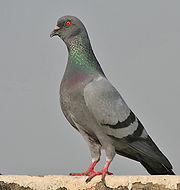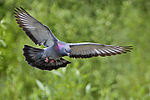
Rock Dove
About this schools Wikipedia selection
This wikipedia selection has been chosen by volunteers helping SOS Children from Wikipedia for this Wikipedia Selection for schools. All children available for child sponsorship from SOS Children are looked after in a family home by the charity. Read more...
| Rock Pigeon | |
|---|---|
 |
|
| Adult C. l. intermedia in India | |
| Conservation status | |
|
Least Concern ( IUCN 3.1) |
|
| Scientific classification | |
| Kingdom: | Animalia |
| Phylum: | Chordata |
| Class: | Aves |
| Order: | Columbiformes |
| Family: | Columbidae |
| Genus: | Columba |
| Species: | C. livia |
| Binomial name | |
| Columba livia Gmelin, 1789 |
|
The Rock Pigeon (Columba livia), or Rock Dove, is a member of the bird family Columbidae (doves and pigeons). In common usage, this bird is often simply referred to as the "pigeon". The species includes the domestic pigeon, and escaped domestic pigeons have given rise to the feral pigeon.
Wild Rock Pigeons are pale grey with two black bars on each wing, although domestic and feral pigeons are very variable in colour and pattern. There are few visible differences between males and females. The species is generally monogamous, with two squabs (young) per brood. Both parents care for the young for a time.
Habitats include various open and semi-open environments, including agricultural and urban areas. Cliffs and rock ledges are used for roosting and breeding in the wild. Originally found wild in Europe, North Africa, and western Asia, feral Rock Pigeons have become established in cities around the world. The species is abundant, with an estimated population of 17 to 28 million feral and wild birds in Europe.
Taxonomy and naming
The Rock Pigeon was first described by Gmelin in 1789. The genus name Columba is the Latinized form of the Ancient Greek κόλυμβος (kolumbos), "a diver", from κολυμβάω (kolumbao), "dive, plunge headlong, swim". Aristophanes (Birds, 304) and others use the word κολυμβίς (kolumbis), "diver", for the name of the bird, because of its swimming motion in the air. The specific epithet is derived from the Latin livor, "bluish". Its closest relative in the Columba genus is the Hill Pigeon, followed by the other rock pigeons: the Snow, Speckled and White-collared Pigeons.
The species is also known as the Rock Dove or Blue Rock Dove, the former being the official name used by the British Ornithologists' Union and the American Ornithologists' Union until 2004, at which point they changed their official listing of the bird to Rock Pigeon. In common usage, this bird is often simply referred to as the "pigeon". Baby pigeons are called squabs.
Subspecies
There are 12 subspecies recognised by Gibbs (2000); some of these may be derived from feral stock.
- C. l. livia, the nominate subspecies, occurs in western and southern Europe, northern Africa, and Asia to western Kazakhstan, the northern Caucasus, Georgia, Cyprus, Turkey and Iraq.
- C. l. atlantis ( Bannerman, 1931) of Madeira, the Azores and Cape Verde, is a very variable population with chequered upperparts obscuring the black wingbars, and is almost certainly derived from feral pigeons.
- C. l. canariensis (Bannerman, 1914) of the Canary Islands, is smaller and averages darker than the nominate subspecies.
- C. l. gymnocyclus (Gray, 1856) from Senegal and Guinea to Ghana and Nigeria is smaller and very much darker than nominate C. l. livia. It is almost blackish on the head, rump and underparts with a white back and the iridescence of the nape extending onto the head.
- C. l. targia (Geyr von Schweppenburg, 1916) breeds in the mountains of the Sahara east to Sudan. It is slightly smaller than the nominate form, with similar plumage, but the back is concolorous with the mantle instead of white.
- C. l. dakhlae ( Richard Meinertzhagen, 1928) is confined to the two oases in central Egypt. It is smaller and much paler than the nominate subspecies.
- C. l. schimperi ( Bonaparte, 1854) is found in the Nile Delta south to northern Sudan. It closely resembles C. l. targia, but has a distinctly paler mantle.
- C. l. palaestinae (Zedlitz, 1912) occurs from Syria to Sinai and Arabia. It is slightly larger than C. l. schimperi and has darker plumage.
- C. l. gaddi (Zarodney & Looudoni, 1906), breeds from Azerbaijan and Iran east to Uzbekistan is larger and paler than C. l. palaestinae with which it intergrades in the west. It also intergrades with the next subspecies to the east.
- C. l. neglecta (Hume, 1873), is found in the mountains of eastern Central Asia. It is similar to the nominate subspecies in size, but is darker with a stronger and more extensive iridescent sheen on the neck. It intergrades with the next race in the south.
- C. l. intermedia ( Strickland, 1844) occurs in Sri Lanka and in India south of the Himalayan range of C. l. neglecta. It is similar to that subspecies, but darker with a less contrasting back.
- C. l. nigricans ( Buturlin, 1908) in Mongolia and north China is variable and probably derived from feral stock.
Description
The adult of the nominate subspecies of the Rock Pigeon is 32–37 cm (12-14½ in) long with a 64–72 cm (25-28 in) wingspan. It has a dark bluish-gray head, neck, and chest with glossy yellowish, greenish, and reddish-purple iridescence along its neck and wing feathers. The iris is orange, red or golden with a paler inner ring, and the bare skin round the eye is bluish-grey. The bill is grey-black with a conspicuous off-white cere, and the feet are purplish-red.
The adult female is almost identical to the male, but the iridescence on the neck is less intense and more restricted to the rear and sides, while that on the breast is often very obscure.
The white lower back of the pure Rock Pigeon is its best identification character, the two black bars on its pale grey wings are also distinctive. The tail has a black band on the end and the outer web of the tail feathers are margined with white. It is strong and quick on the wing, dashing out from sea caves, flying low over the water, its lighter grey rump showing well from above.
Young birds show little lustre and are duller. Eye colour of the pigeon is generally an orange colour but a few pigeons may have white-grey eyes. The eyelids are orange in colour and are encapsulated in a grey-white eye ring. The feet are red to pink.
When circling overhead, the white underwing of the bird becomes conspicuous. In its flight, behaviour, and voice, which is more of a dovecot coo than the phrase of the Wood Pigeon, it is a typical pigeon. Although it is a relatively strong flier, it also glides frequently, holding its wings in a very pronounced V shape as it does. Though fields are visited for grain and green food, it is nowhere so plentiful as to be a pest.
Pigeons feed on the ground in flocks or individually. They roost together in buildings or on walls or statues. When drinking, most birds take small sips and tilt their heads backwards to swallow the water. Pigeons are able to dip their bills into the water and drink continuously without having to tilt their heads back. When disturbed, a pigeon in a group will take off with a noisy clapping sound.
Homing pigeons, are well known for their ability to find their way home from long distances. Despite these demonstrated abilities, wild Rock Pigeons are rather sedentary and rarely leave their local areas.
Distribution and habitat
The Rock Pigeon has a restricted natural resident range in western and southern Europe, North Africa, and into South Asia. The Rock Pigeon is often found in pairs in the breeding season but is usually gregarious. The species (including ferals) has a large range, with an estimated global extent of occurrence of 10 million km². It has a large global population, including an estimated 17–28 million individuals in Europe Fossil evidence suggests the Rock Pigeon originated in southern Asia and skeletal remains unearthed in Israel confirm their existence there for at least three hundred thousand years. Its habitat is natural cliffs, usually on coasts. Its domesticated form, the feral pigeon, has been widely introduced elsewhere, and is common, especially in cities, over much of the world. In Great Britain, Ireland and much of its former range. A Rock Pigeon's life span is anywhere from 3–5 years in the wild to 15 years in captivity, though longer-lived specimens have been reported. The species was first introduced to North America in 1606 at Port Royal, Nova Scotia.
Reproduction

The Rock Pigeon breeds at any time of the year, but peak times are spring and summer. Nesting sites are situated along coastal cliff faces, as well as the artificial cliff faces created by apartment buildings with accessible ledges or roof spaces.
The type of nest constructed is a flimsy platform of straw and sticks, put on ledge, under cover. Often window ledges of buildings. Two white eggs are laid with incubation that is shared by both parents lasting from seventeen to nineteen days.
The nestling has pale yellow down and a flesh-coloured bill with a dark band. It is tended and fed on " crop milk" like other doves. The fledging period is 30 days.
Predators
Pigeons are preyed upon by many different predators with Peregrine Falcons and sparrowhawks being quite adept at catching and feeding upon this species, as shown by the high losses of racing pigeons to these predators. Some common predators of feral pigeons in the North America are opossums, raccoons, Great Horned Owls, and Eastern Screech-owls. Other predators include the Golden Eagle and American Kestrels. On the ground the adults, their young and their eggs are at risk from feral and domestic cats. Doves and pigeons are considered to be game birds as many species have been hunted and used for food in many of the countries in which they are native.
Human health
Pigeons have been associated with a variety of human diseases, including histoplasmosis and cryptococcosis. Pigeons are not a major concern in the spread of West Nile virus; though they can contract it, they do not appear to be able to transmit it. Pigeons are, however, at potential risk for carrying and spreading avian influenza. Although one study has shown that adult pigeons are not clinically susceptible to the most dangerous strain of avian influenza, the H5N1, other studies have presented definitive evidence of clinical signs and neurological lesions resulting from infection. Furthermore, it has been shown that pigeons are susceptible to other strains of avian influenza, such as the H7N7, from which at least one human fatality has been recorded.
Domestication
Rock Pigeons have been domesticated for several thousand years, giving rise to the domestic pigeon (Columba livia domestica). As well as pets, domesticated pigeons are utilised as homing pigeons and carrier pigeons, and so-called war pigeons have served and played important roles during wartimes, with many pigeons having received bravery awards and medals for their services in saving hundreds of human lives: including, notably, the French pigeon Cher Ami who received the Croix de Guerre for his heroic actions during World War I, and the Irish Paddy and the American G.I. Joe, who both received the Dickin Medal, amongst 32 pigeons to receive this medallion, for their gallant and brave actions during World War II. There are numerous breeds of fancy pigeons of all sizes, colours and types.
Feral pigeon
Many domestic birds have escaped or been released over the years, and have given rise to the feral pigeon. These show a variety of plumages, although some have the blue barred pattern like the pure Rock Pigeon does. Feral pigeons are found in large numbers in cities and towns all over the world. The scarcity of the pure wild species is partly due to interbreeding with feral birds.



